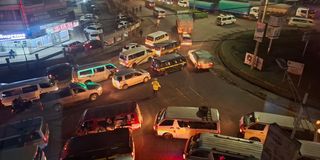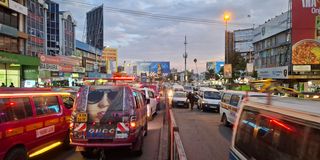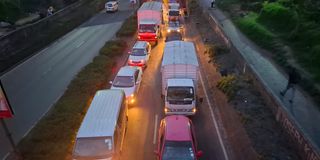Nakuru traffic chaos when it rains: Here is why it happens

Traffic experienced along Gateiguru and roads leading into and out of town around CIGMA building on October 12, 2024.
Local myth has it that when it rains in Nakuru, the ancient spirit of chaos awakens on the roads, possessing motorists and making them forget everything they ever knew about road etiquette.
This mystical amnesia usually turns considerate motorists into impromptu stunt drivers, each seemingly determined to be the first to reach their destination, as a result become the catalyst for causing traffic.
While this can sometimes be the case, especially during morning and evening rush hours, it has increasingly become the norm on rainy days in the CBD.

Traffic experienced along Gateiguru and roads leading into and out of town around CIGMA building on October 12, 2024.
Roads that traffic usually flows smoothly become inexplicable puzzles, with cars weaving in and out as if guided by an unseen, chaotic hand.
Moses Irungu, a motorists observes that people tend to rush home when it is about to rain, mainly because many drivers are unprepared for the rain.
"Some drivers became unsure of how to drive on slippery roads, so they slow down excessively. This hesitation causes traffic jams that could be avoided if everyone was more aware and confident on the road," Irungu says.
His counterpart, Mathew Lesanjo, the secretary general of Nakuru Digital Hailing Sacco, who has years of experience navigating the roads in the CBD, has much more to say.

Traffic experienced along Gateiguru and roads leading into and out of town around CIGMA building on October 12, 2024.
"The roads in Nakuru are currently full of potholes. As a driver, I can usually spot these potholes when the ground is dry and avoid them. But when it rains, our drainage system isn't effective and I may unknowingly hit a pothole. When that happens, I have to slow down and that causes the vehicles behind me to slow down as well, causing traffic," says Lesanjo.
He claims motorists in Nakuru lack courtesy on the road, which also contributes to congestion.
"I have noticed that many drivers in Nakuru don't understand the importance of being courteous and allowing traffic to flow. I would rather drive in Nairobi than here. It's important to let someone through in traffic, especially if they have indicated their intention to merge or turn into a moving lane," he says.
However, he points an accusing finger at the county government and and the Kenya National Highway Authority (Kenha) for sleeping on their jobs in ensuring proper road maintenance.
"I would honestly say that the county government has let us down. For a city, the roads in Nakuru are an embarrassment. We are a city and we should have proper drainage systems that serve road users effectively. Every department has a budget to maintain roads and drainage systems and these funds shouldn't be compromised," says Lesanjo.

Traffic experienced along Gateiguru and roads leading into and out of town around CIGMA building on October 12, 2024.
We caught up with the County Traffic Enforcement Officer for Nakuru County, Amos Namasaka, to get his take on the situation.
"We have been facing challenges with heavy rains, especially around CIGMA/ Railways area where water accumulates significantly. We have written to Kenha to see if they can help with the drainage," says Namasaka.
When it rains, they deploy police and traffic marshals to help direct traffic. But some drivers don't obey the law, especially when visibility is poor.
The stretch of highway from Gateiguru to Eveready and parts of section 58 are particularly prone to congestion. Other roads are less problematic because they have less traffic.
"We typically see a high volume of vehicles during the morning and evening rush hours, even when it's not raining. We've deployed officers along these routes to facilitate movement and ensure traffic flows smoothly," he says.
He agrees that flooding is a major contributor to traffic problems, especially in areas without proper drainage, noting that with two lanes usually available, if one lane is flooded, motorists will avoid it and switch to the other lane, causing congestion.


